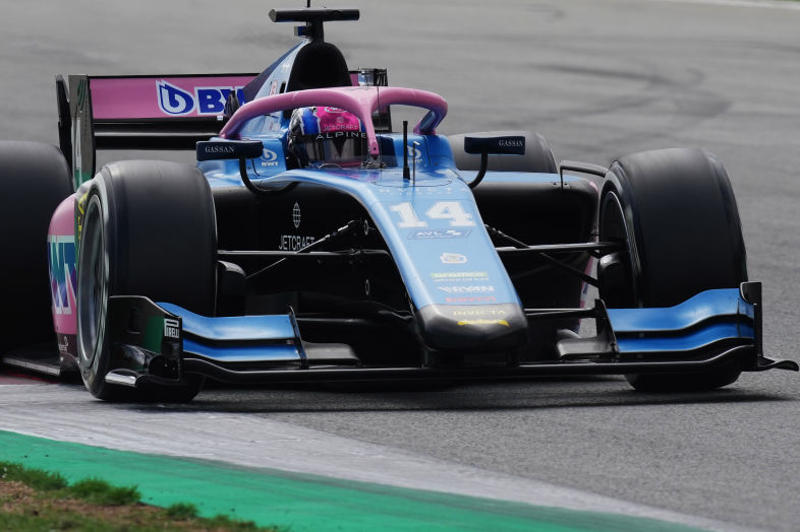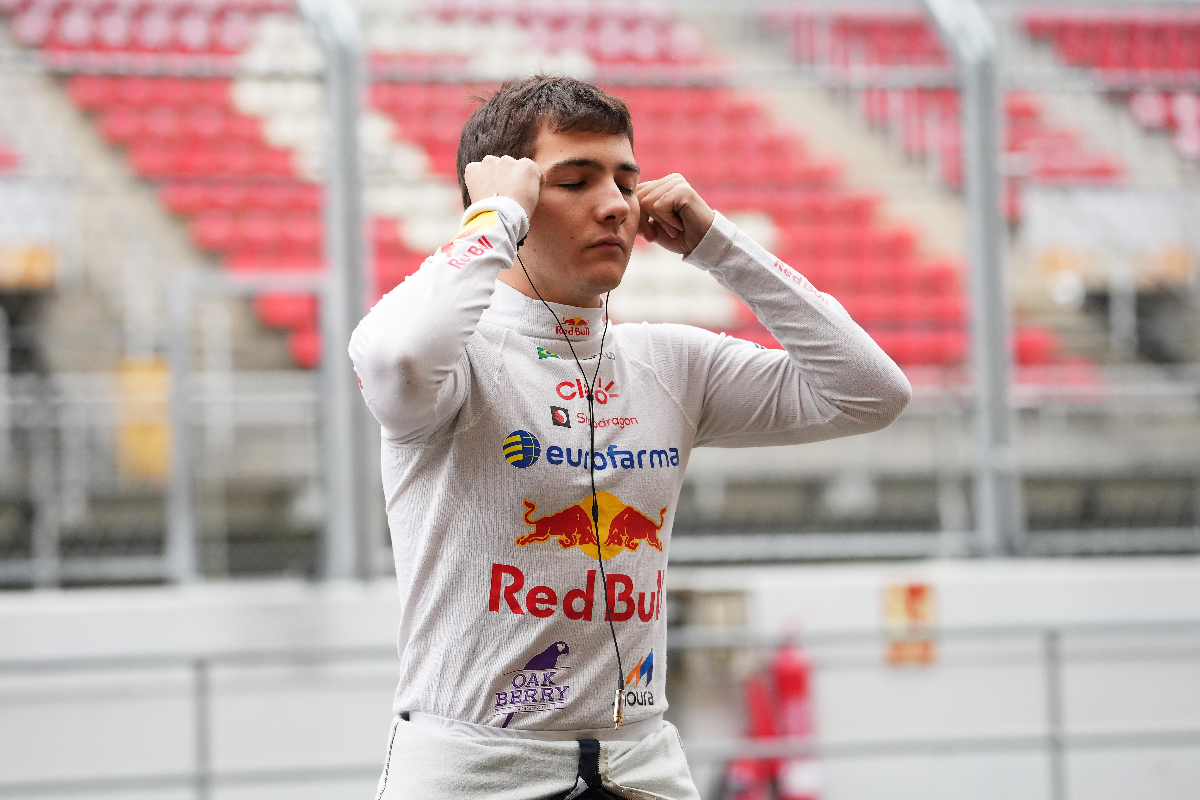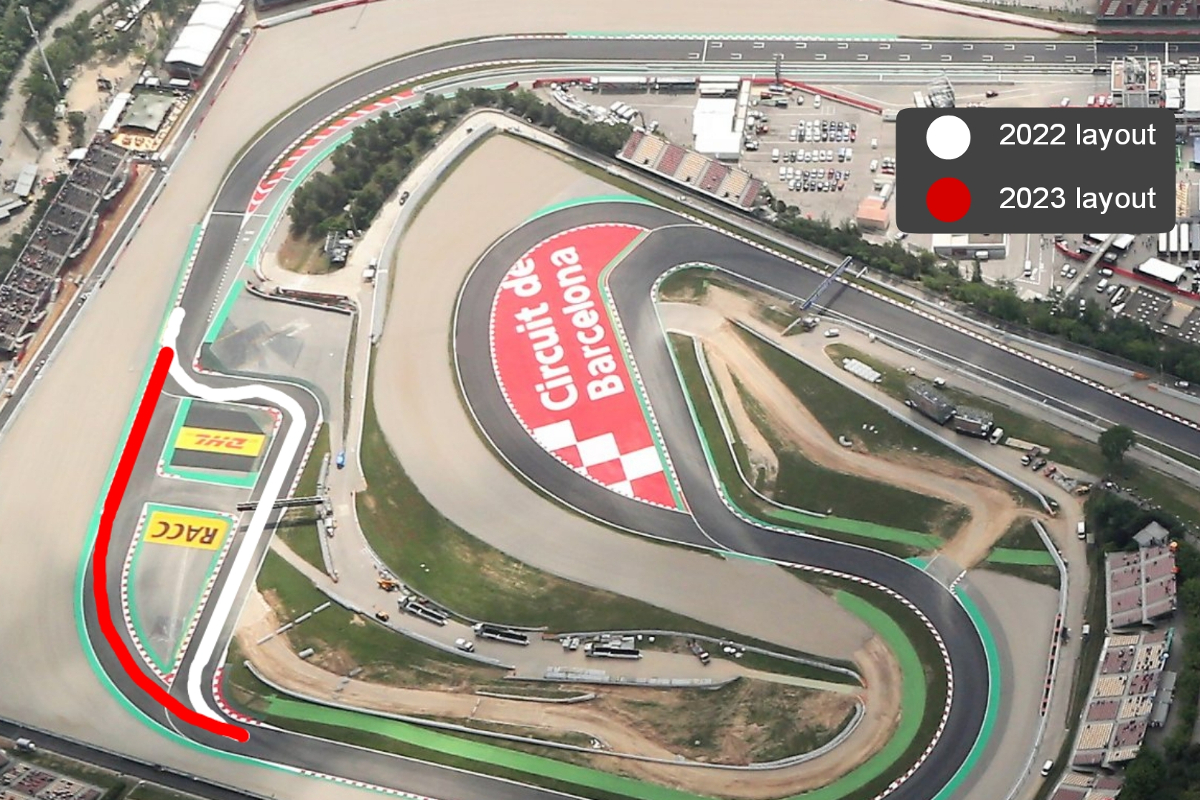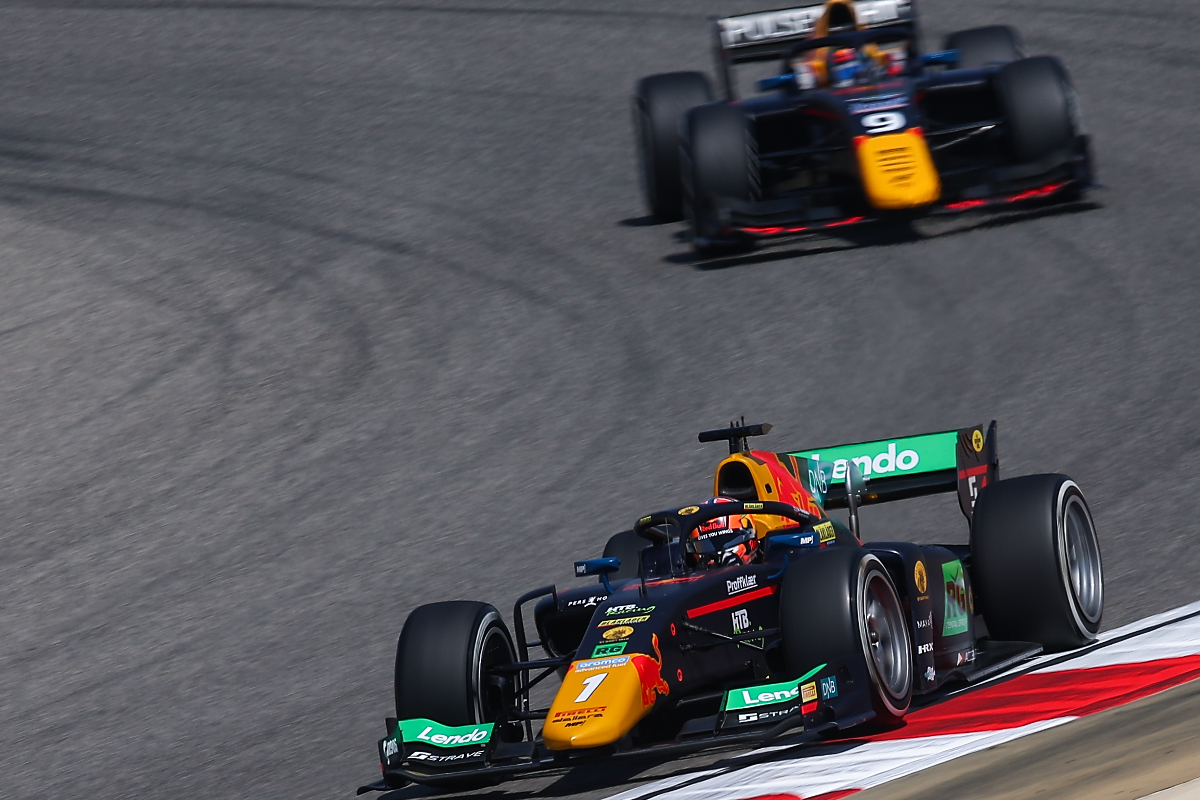
Photos: Formula Motorsport Ltd
F2 drivers gave their verdict on the revised layout of the Barcelona circuit ahead of racing there this weekend
The 2023 field of Formula 1’s main feeder series spoke positively about the changes made to the one of the series’ longest-standing venues, but admitted that overtaking might become even more difficult than it was before.
After several years of discussion, the Circuit of Barcelona-Catalunya reversed to its original version, removing the chicane in the last sector and replacing it for a fast right-hander. Such modification reduced the number of corners from 16 to 14.
The chicane was first introduced back in 2007 in order to guarantee safety in a section where run-off areas were considered too short in the light of ever faster F1 cars. The change was also thought to promote overtaking, but that proved of little effectiveness over the years.
The original version was still used in motorbike racing. However, the fatal accident of Moto2 rider Luis Salom in the second practice session of the 2016 Catalonian Grand Prix prompted immediate changes with motorbikes using the F1 layout in 2016 and 2017 before the run-off of what was former;y turn 13 was extended by 20 metres ahead of 2018.
Since then, race car drivers and fans had called for the removal of the chicane.
The original layout was homologated by the FIA in accordance with Grade 1 standards — the FIA’s highest track certification, which is required for F1 venues— earlier in 2023, as the circuit installed Tecpro barriers at both turns 13 and 14.
Formula Regional European Championship and F1 Academy were the first single-seater categories to drive the new design during a race weekend. Formula 2 and Formula 3 will be next as part of the support bill of F1’s Spanish Grand Prix this weekend, with both series having tested on the chicane-free layout earlier this season.

Photo: Prema
Formula Scout was present at the F2’s in-season test at Barcelona, and spoke to drivers about the revised track design.
“I think it’s extremely cool. Obviously, it’s flat first one through in qualifying and then the second one is definitely a challenge,” said Prema’s current points leader Frederik Vesti. “I don’t know the speed around, but I think it’s more than 200mph, which is obviously a racing driver’s dream.”
“The only thing I’m curious to see for the race weekend is if it’s going to be worse to overtake down the main straight or if it’s going to be all right. So let’s see how it’s going to be during the race weekend, but it will definitely be cool. I like it a lot and I think it’s a good change for the track.”
Ollie Bearman joined his team-mate in speaking positively about the changes. However, he also raised concerns regarding a possible increase in the difficulty of overtaking.
“First of all, it’s really fun to drive. I always prefer a high-speed corner than a low-speed one. It’s always a bit more fun. And especially considering it’s at the end of the lap, the balance is quite difficult,” the Ferrari F1 junior commented.
“I don’t know what it will do for the racing. I tried following a bit a couple laps and it seems difficult to follow, so maybe it won’t be the best. But overall I think it’s a positive change compared to last year.”
Conversely, Virtuosi Racing’s Jack Doohan felt going through the corner in the wake of another car felt alright, but reckoned the previous design allowed drivers to make a bigger difference.
“In all honesty, I was excited for it for sure because it looks really cool and two high-speed corners to finish a lap is really nice.
“I was a little bit hesitant on how it was going to be in a race situation with two high-speed corners being very aero-dependent and even following cars.
 “I didn’t know if that was going to make it more difficult to be able to stay close and you can overtake at the end of the main straight, which is your main overtaking chance here in Barcelona.
“I didn’t know if that was going to make it more difficult to be able to stay close and you can overtake at the end of the main straight, which is your main overtaking chance here in Barcelona.
“Driving it today in both conditions was quite nice, especially on the option [tyre] was great to get a feeling on that and really using the downforce of these cars.
“I was quite happy with the [previous version of[ sector three. It was a very difficult one. It created the opportunity to try and make a difference. But two high-speed corners, I think once everyone gets up to speed at the end of these three days and I’m pretty sure it will be quite close there.”
“I have the feeling that it’s a lot better than the chicane,” DAMS’ Arthur Leclerc claimed as he pointed out the challenge posed by the old version. “The chicane is really slow. You come around these tyres in sector three with really hot tyres, really high temperatures, so obviously the car is a lot more difficult to drive.
“In slow corners, let’s say it was a bit more boring. So I think with the high-speed corner will be better. Even in the race, it will be two tricky corners to manage. It will bring even more difference of tyre management in the race. I’m quite happy with these two corners.
“It’s more physical because now you don’t have a really slow corner. Obviously, the faster you go in the corner, the more downforce you have and more the steering is heavy.
“This is a bit different compared to last year and the steering I think is the heaviest now in these two last corners. It’s changing a bit your approach physically and as well as mentally because you need to think about other stuff with the tyre management.”
Trident’s Roman Stanek found it “much harder than in the past” and said he “will have to train the neck for the race especially”.
 Opposite to fellow drivers, both Rodin Carlin competitors weren’t convinced about the modification straight away. Track time changed the mind of Enzo Fittipaldi [pictured above], but Zane Maloney remained adamant he liked the final sector as it was before, especially in dry conditions, as it suited his driving style.
Opposite to fellow drivers, both Rodin Carlin competitors weren’t convinced about the modification straight away. Track time changed the mind of Enzo Fittipaldi [pictured above], but Zane Maloney remained adamant he liked the final sector as it was before, especially in dry conditions, as it suited his driving style.
“At first I was kind of questioning it,” Fittipaldi confessed. “I thought the chicane was always a very nice part of the Barcelona circuit, the last sector.
“After doing the first laps here in Barcelona yesterday and feeling the last sector, it was really nice. The last two corners, they are very high-speed corners, and difficult corners, especially the last corner is a very high-speed corner.
“Now we have many high-speed corners in Barcelona, we have turn three, turn nine, turn 13 and 14, which is the last corner. So I like the new configuration. I think it will make racing interesting because obviously now with these very fast last two corners, the left-front will struggle even more here. So it should make the racing a little bit more interesting.”
Meanwhile Maloney said: “I preferred how it was before, to be honest. I always used to love the last sector in Barcelona, especially on a qualifying lap because you come to the last sector with the rears already hanging on for their life and then you have to get through lots of third and second gear corners.
“I always used to like that. I always used to be quick in the last sector, but it’s still nice. Hopefully it will improve racing. I’m not sure if it will to be honest, we’ll see. It’s going to be quite hard to follow, I think.
“In terms of a qualifying lap now, it’s completely different because now you’re not having to worry as much about the rears going away. It has changed the dynamics of the track, but it’s like any other track. It’s a different corner really. It’s not much else other than that. It’s quite sketchy in the two really high-speed corners, which is cool.
 “The second to last one is flat pretty much. The last one is the real sketchy one, you have to just hang on for life. But yes, it’s quite nice,” Maloney admitted in the end.
“The second to last one is flat pretty much. The last one is the real sketchy one, you have to just hang on for life. But yes, it’s quite nice,” Maloney admitted in the end.
The test was F2 drivers’ first time driving the circuit original layout, which made ART Grand Prix’s Theo Pourchaire approach it as a completely new track. The Sauber junior dived into how the two corners feel from inside the cockpit.
“I just trained a bit in the F1 simulator in Sauber and also in the F2 simulator, but it’s completely new for everyone. It’s a lot faster. Turn 13 is the penultimate corner and it’s blind in entry. We don’t see anything, so you need to do some laps,” he said after the first day of running.
“This day was just about getting used to the new track layout and because you don’t know where to turn at first and it’s a normal flat corner, so very impressive. The last one as well, there is a small break [from the throttle] in F2, but it’s very, very impressive. There is not a lot of run-off area, it’s gravel and the wall straight away. So if you go out there, it can be dangerous.
“It’s a nice, nice layout. It’s different. I don’t know if it’s better or not. Hopefully it’s better for the overtakes on track, but I’m not 100% sure about this.
“Now it’s a high-speed track. There is mostly high-speed and medium-speed corners, only one slow-speed, turn five, but it’s not a proper slow-speed corner. It’s still a long one and different compared to a very small chicane, last year’s chicane or a hairpin.
“It’s a high-speed track, different as well for the tyre management because now it feels like it will be a bit more difficult for the front tyres. Last year, sometimes it was difficult for the rear tyres and sometimes for the fronts, now it’s more and more the front-left tyre. We will have to take care of that because it changed a lot the balance of the car and the tyre management for the driver.

The front-left tyre and driver’s necks will be worked hard
“Also for the neck, it’s a bit difficult now. The neck and also the arms, it’s pretty difficult because the faster the corner is, the heavier the steering wheel gets. So it’s very difficult the last two corners, but it’s enjoyable,” Pourchaire concluded.
Barcelona now has four high-speed right-handers and two medium-speed ones, which means the left-front tyre will be drivers’ main headache during the races. Therefore, set-ups from previous years will need significant adjustment as there is no longer a section where traction is the main priority.
“You’re having to prioritise slightly different balance as before we only really had turn three and turn nine, which were high-speed corners,” explained Doohan.
“Now you have a last sector with two flat-out right-hand corners. The second one not being so flat, but yeah, it’s quite on the limit. So your balance has to change slightly and you have to try and prioritise one on one.
“I’ll give more insight into direction after the Barcelona race weekend, but it definitely changes it from last year for sure. Definitely your trade-off between high-speed and slow-speed corners is more equal than it was.”
Bearman said the track modifications means car balance “is changing a lot” in all areas: “Without the last chicane, you have a bit less tyre degradation through the lap because there’s less heavy traction zones. But on the other hand, those two last corners are very high speed, very high energy.
“The thing is, I think it [the difference] will be more in consecutive laps because there is a different kind of distribution of the energy that’s given to the tyre through the lap. So, of course, when you do consecutive laps, it will be maybe a bit different.
MP Motorsport’s Dennis Hauger also commented on the long-term impact on tyres. “It’s going to probably change a bit the degradation and everything that’s going on for us on the tyres with two high-speed right handers. There’s going to be quite a lot of energy on the left side, which already is. So it’s going to change a few things.

Photo: Red Bull Content Pool
“For opportunities in passing, I don’t know if it will change much. We will get more on the understeer into the last corner, so I don’t know if we will get the exit. We’ll see in the race, but overall it’s cool and fast, a bit different, but it’s alright.”
The Norwegian also mentioned what will be the key to getting qualifying right.
“I think for qualifying it’s going to be important to nail the last corner mainly, and even get a good exit out of turn 12 [the preceding hairpin]. That’s just a bit of a different way of getting around. And also for qualifying in terms of tyres getting ready and stuff like that, you have a bit less time, so it changes quite a few more factors because it’s the last corners.”
Rain hit during days the second and third days of the test, which allowed drivers to have a taste of the last two corners in full wet conditions.
“It’s a big difference to the dry,” said Maloney. “Of course, the rubber going down, it then becomes two high-speed corners that you need to stay off the rubber.
“In the wet, I quite like it because it’s two more corners that you can make a big difference. You can lose a lot of time, you can gain a lot of time. Whereas the last sector, how it used to be in the wet, it was more one line that you can do really, whereas now you can really try different things and there’s bigger differences.”
Whether racing will improve is yet to be seen even though prospects don’t invite to be optimistic. Nevertheless, one thing is clear, the chicane-free Barcelona layout is considerably faster than before. Pourchaire’s fastest lap across the three days of testing was a 1m23.943s, which was 3.586 seconds faster than F2’s 2022 benchmark set by MP’s Felipe Drugovich.